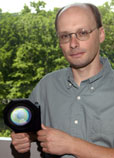|
|
|
|
|
 |

|
 |
 |
|
|
 Download print version Download print version
[Download free Acrobat Reader]
|
 |
|
Contents:

Awards Bestowed and Partnership Praised at NTR Program

spotlight on spin-in:
Pursuing Partnerships for Robotics Sensing/Imaging

researcher profile:
Matthew McGill

signature success:
Three Newly Signed Agreements

Recent Events

Two Space Act Board Awards Issued

Tech Transfer Metrics
- January 1-March 31, 2005

Send Us Your Ideas

Submit Your New Technologies
 |
Awards Bestowed and Partnership Praised at NTR Program
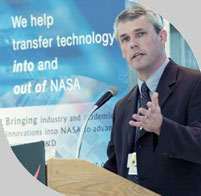
In accepting the 2005 Kerley Award, Peter Shirron (Code 552) recalls
Dr. James Kerley’s “creative genius that he used to benefit not only NASA, but mankind in general.”
“This award is special to me because of the respect and admiration I had for Jim Kerley. I got to know Jim initially because my office was down the hall from his. But I came to know him even better because both of us swam at the Greenbelt pool most days at lunchtime, and we would talk during breaks. From those talks, he impressed me as a very gentle, unassuming man. But as anyone who saw him working or saw his work displayed at Goddard Days can attest, Jim had a real creative genius that he used to benefit not only NASA but mankind in general. To me, Jim embodied what is truly great about working at NASA: the opportunity to work among outstanding people, conducting cutting-edge research, and contributing to an enterprise dedicated to discovery and learning. The presence of so many people at Goddard who embrace these ideals is really what makes giving this award meaningful. I feel honored to have been considered for this award, and pleased to think that I am seen as contributing to these goals too.”
|
On April 7th, more than 100 Goddard scientists and researchers gathered at the Newton White Mansion in Mitchellville, Maryland to celebrate their achievements in the field of technology transfer. These individuals had submitted New Technology Reports (NTRs or invention disclosures) or otherwise participated in technology transfer during 2004.
“New Technology Reporting is the critical first step to technology transfer,” said Nona Cheeks, chief of Goddard’s Innovative Partnerships Program (IPP) Office, during her opening remarks. “We are extremely indebted to all of you who have reported your new technology developments.”
Director of the Applied Engineering and Technology Directorate Mike Ryschkewitsch (Code 500) discussed spin-in partnerships, their value, and how IPP can help researchers form high-impact partnerships. “I was very pleased to learn that NASA Tech Transfer is now a two-way process,” commented attendee Irving Linares (Code 564). “There is a significant number of ideas and technologies used for medical instruments, for instance, that have been incorporated into now orbiting satellites.”
In addition, IPP and the Office of Patent Counsel bestowed several awards, including patent awards and the Kerley Award. Attendees also heard about a successful spin-in partnership.
Patent Awards
Fifteen innovators were given a plaque and cash award for having their technologies patented during 2004. (All issued patents are listed in the “Metrics” section of every issue of Goddard Tech Transfer News.) “I was honored to join many distinguished guests at the breakfast,” said Per Gloersen (Code 614), who received his plaque from Center Director Ed Weiler.
Kerley Award
The Kerley Award is presented annually to a Goddard innovator who demonstrates exceptional commitment to technology transfer. The 2005 recipient was Peter Shirron (Code 552) for his work in transferring his adiabatic demagnetization refrigerator (ADR) technology. “This award is special to me because of the respect and admiration I had for Jim Kerley,” reflected Dr. Shirron. “I feel honored to have been considered for this award, and I would like to thank the entire Innovative Partnerships Program Office for their support of my work on ADRs over the last few years. Perhaps unique among support groups at the Center, the Tech Transfer folks really act as our advocates, and it is a pleasure to work with such motivated and friendly people.”
Spin-in Partnership
D. Barry Coyle (Code 690) was joined by Gregg Switzer of AdvR Inc. in presenting their partnership to improve lasers used in space exploration. Goddard and AdvR have been working together to develop a space-qualified seed laser that is smaller and more efficient, uses fewer components, and costs significantly less than what is currently available.
|
|
|

Spin-In vs. Spin-Out
Spin-in: Partnering with or adapting technologies from industry, academia, or other government labs to address NASA mission needs.
Spin-out: Finding commercial, academic, and other government applications for NASA technologies.
|

|
|
|

spotlight on spin-in:
Pursuing Partnerships for Robotics Sensing/Imaging
As the Headquarters Innovative Partnerships Program (IPP) Office pursues technology infusion (spin-in), Goddard is leading the charge in the area of sensing and imaging for robotics.
IPP’s “Infusion Project” is an effort to systematically find innovative partnerships to advance NASA’s goals for space exploration. After analyzing NASA’s capabilities and competencies, IPP established teams to pursue partnerships in five areas:
- Sensing and Imaging for Robotics
- Autonomy and Intelligence
- Advanced Materials and Structures
- Energy Conversion, Storage, and Management
- Systems Health Management
Although this is a NASA-wide effort, the work related to sensing and imaging is headed by Goddard.
“We have extensive expertise and experience in these areas as well as a unique opportunity to apply them to the Agency’s new Vision for Space Exploration,” said Goddard’s chief technologist Peter Hughes (Code 502). “The potential for partnerships leveraging external innovations and contributions is very high.”
That potential is tied to the fact that industry—as well as academia and government-funded agencies—has a lot to gain from partnering with NASA. Industry-NASA partnerships are essentially dual-use projects that meet NASA’s needs as well as the current and future needs of industry.
“What we‘re doing now,” explained OTT’s Joe Famiglietti, “is interviewing principal investigators and project managers at Goddard and throughout NASA to try to precisely define what their needs and specific research challenges are.”
This information will be used to connect with potential partners at conferences, such as the RoboBusiness conference in May, at upcoming industry briefings, and through other outreach efforts.
If you are interested in partnering with a company, university, or government laboratory to conduct joint research that advances NASA’s space exploration or other research goals—in any area—contact IPP contractor Nannette Stangle-Castor (919-873-1457).

|
|
|

researcher profile:
Matthew McGill
|
|
|
Code 613
8 years at NASA
Education: B.S. in physics, Alma College; M.S. in atmospheric science,
University of Michigan; Ph.D. in atmospheric science, University of Michigan
Born: Alma, Michigan
|
Tell us about your work with IPP. What have you been doing?
I’ve been disclosing inventions and working with IPP since about 1997. One of the disclosures has been patented, so I worked with IPP and patent counsel in writing the patent application. I applied for and received funding from IPP to pursue additional development of one of my technologies. Then IPP helped me gain visibility for the technology, taking it to conferences either with me or using a display we jointly developed. In fact, that was how IPP found a licensee for my technology.
How have you benefited from this work?
I’m particularly lucky because we were able to get a license in place, so I’ll get royalties along with the patent and other awards I’ve received for my work with IPP. But more important are the opportunities to find innovative uses for NASA technology. When I disclosed a technology specific to our applications in lidar remote sensing, I never imagined that the technology could be used for monitoring drinking water supplies. But IPP and the work they do got me out of the lab and interacting with other technical, creative people, and an innovative company saw an application that never would have occurred to me.
Any advice for your colleagues?
If you have an invention, disclose it to IPP! You just might get a patent or a license out of it. But you won’t get either if you don’t submit the New Technology Report (NTR). And be prepared to be patient. A license isn’t put in place overnight. Sometimes a company needs a lot of time before they’re ready to take on your invention. Finally, I can attest that the folks in IPP have been wonderful to work with and always have the inventor’s best interests in mind.

|
|
|
|

signature success
Three Newly Signed Agreements The Innovative Partnerships Program Office is proud to announce that it recently signed three agreements for spin-out of Goddard technology and dual-use partnerships (spin-in). “These agreements put us well over our spin-in goal for the year,” said IPP chief Nona Cheeks. “I’m so pleased that we hit the target so early. I think it’s a real benefit for Goddard’s innovators as well as NASA as a whole.” All three of these partnerships will advance NASA’s science and space exploration goals.
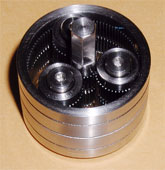 |
Technology: Gear Bearings
Inventor: John Vranish (Code 544)
Type of agreement: Nonreimbursable Space Act Agreement
Date signed: February 23, 2005
Partner: Eaton Aerospace
Eaton Aerospace, subcontractor to Lockheed Martin for the development of the Defense Department’s F-35, will design, fabricate, and test an actuator that incorporates Goddard’s gear bearing technology for use in the state-of-the-art fighter jet. Currently, Eaton’s actuator exceeds size and weight specifications, and Goddard’s technology is expected to enable the necessary reductions. This work will advance gear bearings’ technology readiness level (TRL) and reduce NASA’s costs for flight-qualifying the technology. TRL advances also will accelerate the use of gear bearings in NASA’s many potential space exploration applications (e.g., robotics, space tools, rovers).
|
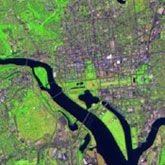 |
Technology: Hierarchical Segmentation (HSEG) Software
Inventor: James Tilton (Code 606)
Type of agreement: Letter of Agreement
Date signed: December 23, 2004
Partner: Universidad de Extremadura in Spain (UEX)
Researchers at Goddard and UEX are combining their expertise and respective algorithms to improve hyperspectral imaging. The goal is to develop new algorithms that increase the efficiency of parallel processing of imaging data. Under the agreement, UEX has access to the HSEG algorithms as well as remote access to Goddard’s Beowulf PC clusters for parallel processing. Similarly, Goddard has access to UEX’s hyperspectral scene data collected over various semiarid areas in Spain. Advances in HSEG will further enhance its applicability to planetary exploration and terrainmapping
|
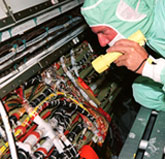 |
Technology: Hilbert Huang Transform (HHT)
Inventor: Norden Huang (Code 614)
Type of agreement: Reimbursable SAA
Date signed: March 29, 2005
Partner: Goodrich Corp.
As part of a project with the Federal Aviation Administration (FAA), Goodrich is working to improve safety of commercial aircraft wiring systems. Under this effort, Goodrich now is studying the applicability of Goddard’s HHT technology to inspection, fault analysis, and diagnosis of various types of wires. Goddard is providing technical expertise to assist Goodrich with its work. Goodrich’s advances not only will enhance the safety of aircraft but also can be applied to wire inspection, fault analysis, and diagnostics for the Exploration Systems and Aeronautics Research Mission Directorates.
|

|
|
|

recent events
|
| Event |
Technologies/topics |
Outcome |
Transportation Research Board
Annual Meeting |
NASA’s research on electromagnetic launch
assist (EMLA) |
• Explored partnership opportunities
• Promoted June EMLA workshop |
|
Technology Transfer in the
the Mid-Atlantic: Capitalizing on
Opportunities in 2005 |
Spin-in/Spin-out |
• Explored opportunities for partnerships within the
Mid-Atlantic and Greater Washington regions |
|
National Design and
Engineering Show 2005 |
Conformal Robotic Gripper
Dead-End Welding Device
Gear Bearings
Hilbert Huang Transform
Miniature Probe/Pump
Micron & Submicron Pointed Structures |
• Company interest in prototype licenses for gear bearings
• Company interest in probe/pump
• Company interest in Goddard software |
|

|
|
|

Two Space Act Board Awards Issued
NASA’s Invention and Contributions Board recognized the following innovations with a Space Act Board Award:
These awards, which can reach a maximum of $100,000, are bestowed for technologies with significant scientific and technical contributions. To be eligible, innovations must have been reported through a New Technology Report (NTR), which can be accessed through the online eNTRe system. Once an NTR has been filed, IPP can help innovators prepare the Space Act Award application (Form 1329).
For more information, see the Awards section of OTT’s Web site.

|
|
|

Tech Transfer Metrics
January 1 to March 31, 2005
New technologies reported: 26
New technologies were reported by the following civil servants, contractors, and universities:
Civil Servants
Code 500
Alan Cudmore: Board Support Package for the RTEMS Real-Time Operating System on the Motorola MCF5307C3 Processor Board
Bruce Dean: Alignment Insensitive Active Center-of-Curvature Wavefront Sensing and Control Telescope Architecture
Lee Feinberg: Alignment Insensitive Active Center-of-Curvature Wavefront Sensing and Control Telescope Architecture
Yury Flom: Method of Construction of Truss Structures in Space
John Hagopian: Alignment Insensitive Active Center-of-Curvature Wavefront Sensing and Control Telescope Architecture
Brian Harris: Use of Strain Gages to Detect Bonded Joint Failures of Integrated Science Instrument Module (ISIM) at Cryogenic Temperatures
Joe Howard: Alignment Insensitive Active Center-of-Curvature Wavefront Sensing and Control Telescope Architecture
Michael Kraniak: Method for Improved Geiger-Mode Photon Counting with Avalanche Photodiodes by Reducing After-Pulsing
Douglas Leviton: Light Direction Sensor
Timothy Ray: CCSDS File Delivery Protocol (CFDP) Software Library
David Robinson: Aluminum Substrates for Zeolite Molecular Absorbers
John Vranish: Modular Gear Bearings
|
Code 600
Samuel Floyd: Automated Spectroscopy of X-Ray Fluorescence Spectra
Timothy McClanahan: Automated Spectroscopy of X-Ray Fluorescence Spectra
James Tilton: Split-Remerge Method for Eliminating Processing Window Artifacts in Recursive Hierarchical Segmentation (HSEG); Innovative Utilization of the Heap Data Structure for EfficientDetermination of Best Merges for HSEG
Jacob Trombka: Automated Spectroscopy of X-Ray Fluorescence Spectra
Contractors:
Accurate Automation Corporation
Advanced Technology Management
Orville Fleming
Rust Design
Science Systems and Applications
Sigma Space Corporation
Swales Aerospace
Universities:
Northwestern University
University of Kentucky
University of Maryland–Baltimore County
University of Washington
Worcester Polytechnic Institute
|
Software Release: 3
Innovators receive a $500 to $1,000 award for software approved for public release.
- General EQFlux, Edward Gaddy (Code 563)
- Integrated Structural Analysis and Test Program, Daniel Kaufman (Code 542)
- Shuttle InfraRed Image Analysis Software (SIRIAS), Donald Jennings (Code 693), Brian Ottens (Code 553), and Bradford Parker (Code 541)
|
Issued Patents: 3
Innovators receive a $500 to $1,000 award for an issued patent. [Links open new browser windows.]
- U.S. Patent #6,844,856: Minimum Cycle Slip Airborne Differential Carrier Phase GPS Antenna, Charles Wright (Code 614)
- U.S. Patent #6,862,558: Empirical Mode Decomposition for Analyzing Acoustical Signals, Norden Huang (Code 614)
- U.S. Patent #6,847,354: 3-D Interactive Display, John Vranish (Code 544)
Patent Applications Filed: 2
- Phase-Oriented Gears, John Vranish (Code 544)
- Real-Time Parylene-Thickness Monitoring Optical Sensor System, Michael Beamesderfer (Code 541)
|
Provisional Patents Filed: 4
- Conformal Gripper, John Vranish (Code 544)
- Hardware and Technique for Dead-End Welding of All Types of Tubing, Michael Wilks (Code 597)
- Shuttle InfraRed Image Analysis Software (SIRIAS), Brian Ottens (Code 556), Bradford Parker (Code 541), and Donald Jennings (Code 693)
- Template for Deposition of Micron and Submicron Pointed Structures, Diane Pugel (Code 553)
|

|
|
|

Send Us Your Ideas
We want to do all we can to make it easy and rewarding for you to participate in the Technology Transfer Program. But we need your help. Send us your ideas for program improvements or News articles via email.

|
|
|

Submit Your New Technologies
You can report new project technologies by submitting the online form on eNTRe.

|
|
|

A publication of
Innovative Partnerships Program Office
Mailstop 504
Building 22, Room 290
(301) 286-5810
techtransfer@gsfc.nasa.gov

|
|
|
|
|
|
|
|
|
|




